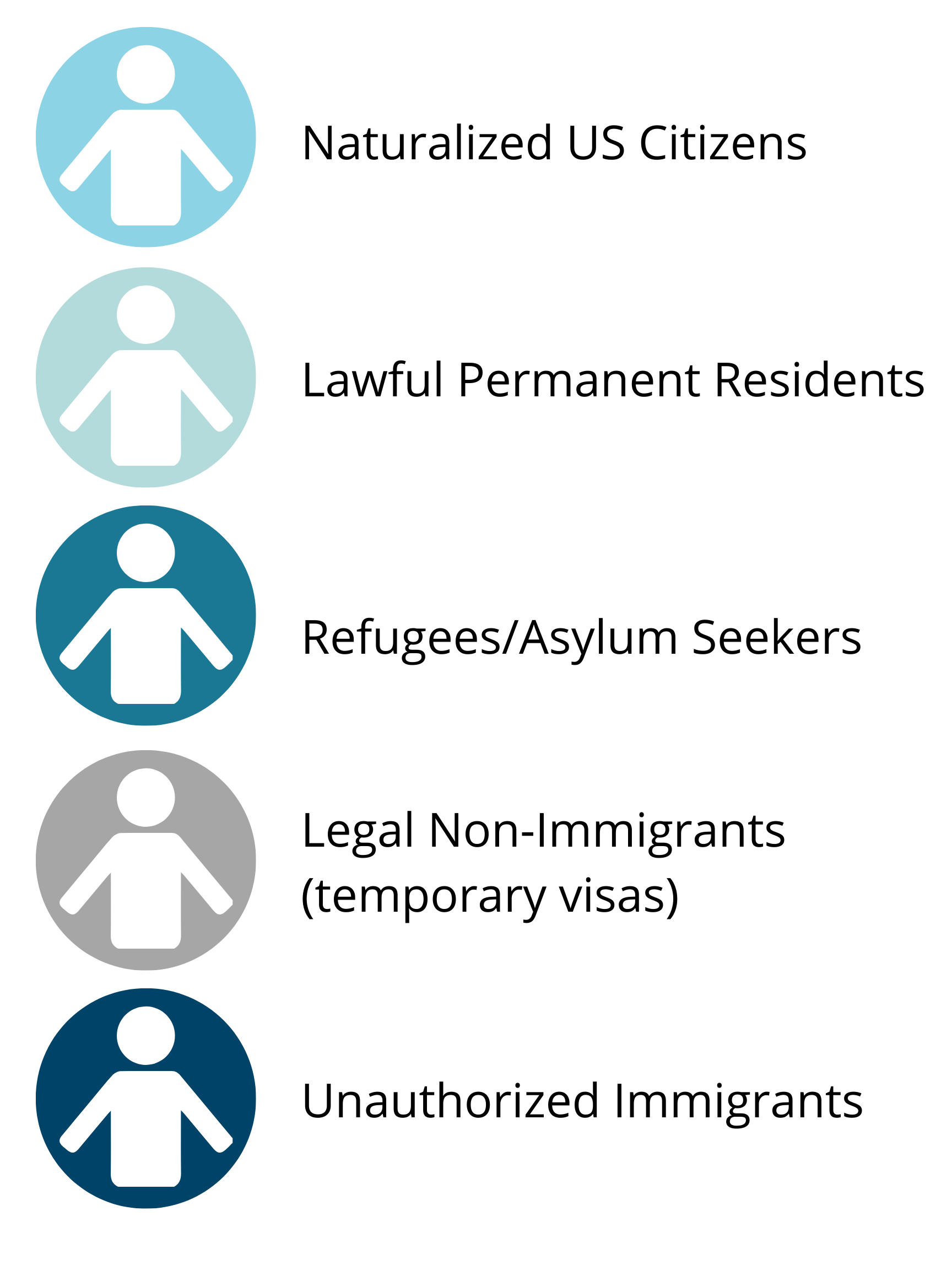Demystifying Immigrants



Photo by Renan Kamikoga on Unsplash
Photo by Renan Kamikoga on Unsplash

Photo by Dan Calderwood on Unsplash
Photo by Dan Calderwood on Unsplash
immigrant (noun): a person who migrates to another country, usually for permanent residence
In the United States, there are five primary types of foreign-born migrants (Migration Policy Institute 2019). The most common are naturalized US citizens who applied for citizenship after holding a green card and living as permanent residents in the US for at least five years. There are also lawful permanent residents (LPRs), also known as green card holders, who are allowed to stay in the country indefinitely as long as they abide by a set of rules and they can also be referred to as legal non-citizens. Refugees and asylum seekers are displaced persons who are allowed residence in the country after a verification process and once fully approved, they are classified legally as LPRs. Next, there are legal non-immigrants who are have arrived on a visa and have a finite timeline to which they are able to reside in the country. Lastly, there are unauthorized immigrants or sometimes referred to as illegal immigrants or undocumented immigrants. Unauthorized immigrants do not have approved residence or citizenship to stay in the country.
While these are the five main types of immigrants, there are more legal classifications within these categories that differentiate between the rights each person is granted.
Approximately, 14% of the US Population in 2017 compromised of immigrants. It's important to note that all native born US citizens are 1st, 2nd, or 3rd generation immigrants except for those who belong to indigenous native american tribes. The following data is solemnly based on immigration defined as a current legal status, not as a cultural or social identity.
(Data: National Conference of State Legislatures 2019)
(Data: National Conference of State Legislatures 2019)
(Data: National Conference of State Legislatures 2019)
(Data: National Conference of State Legislatures 2019)
To further put these numbers into perspective about 1 in 8 US residents is an immigrant.
(Data: American Immigrant Council 2017)
(Data: American Immigrant Council 2017)
From climate change to technological advances to political upheaval, there are a number of reasons that numerous families and individuals flee their home countries in the search for better opportunities. Consequently, where these people come from has changed vastly over the years.
In the 1900s, majority of the immigrants were coming from European nations, largely due to the active world wars. As the political and economical climate changed, the trend begin shifting and many more migrants are seen coming from the Americas (primarily South America). The trend continues into the last decade of the 2000s.
(Data: Migration Policy Institute tabulation for 1960 to 1990, Campbell J. Gibson and Emily Lennon, "Historical Census Statistics on the Foreign-born Population of the United States: 1850-1990," U.S. Census Bureau)
(Data: Migration Policy Institute tabulation for 1960 to 1990, Campbell J. Gibson and Emily Lennon, "Historical Census Statistics on the Foreign-born Population of the United States: 1850-1990," U.S. Census Bureau)
(Data: Migration Policy Institute tabulation from the U.S. Census Bureau's 2006 to 2017 American Community Survey (ACS) and 2000 Decennial Census)
(Data: Migration Policy Institute tabulation from the U.S. Census Bureau's 2006 to 2017 American Community Survey (ACS) and 2000 Decennial Census)
While the make up of immigrants has changed, the current discourse around the implications of immigrants is high and these stories have lead to policies that separate families, invested large financial sums of taxpayer dollars to border control, and have fueled a rise in hate crimes.
Increasingly, the global society including Americans have a fear of immigrants. On November 1st, 2016, the United Nations published a press release describing the rise of xenophobia as a global phenomenon (United Nations Press 2016). In a 2017 study, researchers found that 73% of those who voted for Brexit said they feared immigration (Independent UK 2017). Furthermore, Chapman University's national study found that 40.8% of Americans have some fear in regards to illegal or unauthorized immigration (Chapman University 2018).
So, do Americans need to be concerned about immigrants? Let's walk through three popular myths and the data behind them.
Myth 1: Unauthorized Immigrants pose a Threat to the Safety of Americans

Chapman University annually conducts a national survey to understand what concerns an average American. In their most recent study, they found that 21.5% of Americans are afraid or very afraid of illegal or unauthorized immigration, referring to individuals and families who are undocumented. This fear is ranked ahead of 26 other listed fears, including flying. About 12.7% of Americans are afraid or very afraid of flying, (Bader, Day & Gordon. Chapman University 2018). What are the chances of actually being in a plane crash or being murdered by an illegal immigrant?
12.7% of Americans are afraid or very afraid of flying and 21.5% are afraid of unauthorized immigration.

The visualization gives just a very small insight into how unlikely it is that an unauthorized immigrants pose a threat to the safety of the American population.
Myth 2: An Influx of Immigrants Increases Crime Rates

The previous data focused on authorized immigrants and the chance of life-threatening danger. What about the rates of crime overall, how are these rates affected by an increase in all types of immigrants?
(Data estimates from American Community Survey and F.B.I. Uniform Crime Reporting Program, accessed via Center for Immigration Studies 2009)
(Data estimates from American Community Survey and F.B.I. Uniform Crime Reporting Program, accessed via Center for Immigration Studies 2009)
The data from the American Community Survey and the FBI Crime Program shows a clear indication that there is no direct correlation between crime and immigration. While immigrant populations have continued to increase since the 1970s in the United States, the rates of crimes has been declining since the 1990s.
Myth 3: Immigrants don't Contribute to the US Economy

Immigrants make up 17% of the US Labor Force and 25% of the US Business Owners are Immigrants.
(Data: American Immigration Council, 2017)
(Data: American Immigration Council, 2017)
8.0 million people are employed by US immigrant business owners and their sales contribute $1.3 trillion dollars to the US economy (New American Economy 2017).
(Data: New American Economy 2019)
(Data: New American Economy 2019)
Of the 2019 Fortune 500 firms, 44.6 % of at least one of the founders immigrated to the US or is a child of immigrants. 13.5 million people are employed by these firms and an estimated $6.1 trillion dollars is generated in revenue. (New American Economy 2019).
All of these numbers show a clear indication that immigrants are integrated heavily in the US economy.
Discourse about immigration and immigrants in the United States is heavily present in the current political climate. Yet research and data on immigrants is not being discussed as often and even less so are the stories of immigrant communities.
Out of the countless sound-bytes on immigrants today, it is our duty as a democratic nation to seek the truth and to empower the voices of those to whom it belongs to.
1. SHARE one thing you learned today
2. ENGAGE with an organization that amplifies the voices of immigrant communities
3. VOTE
Published December 2019. A data visualization story by Maria T. Khan, M.S. Candidate at Carnegie Mellon University .











